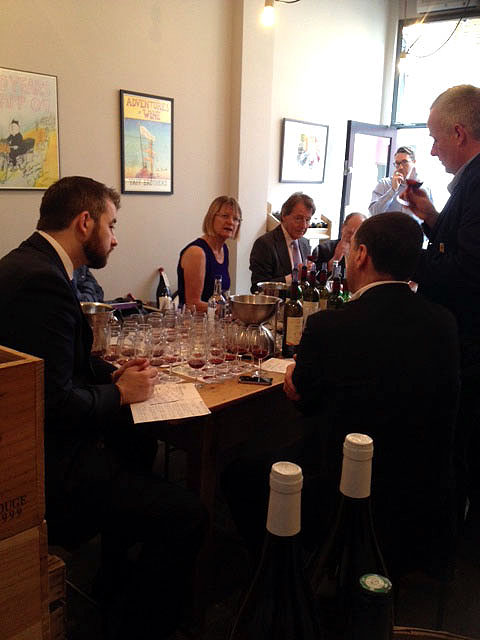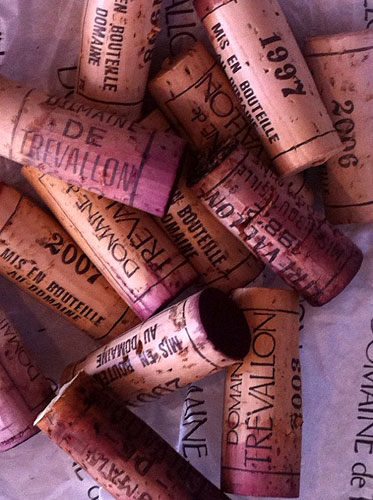Back in July, at our pop-up shop in Exmouth Market, Jason hosted a tutored vertical tasting of the thrilling wines of Domaine de Trévallon, Eloi Durrbach’s world-famous domaine with wines dating back to the early Eighties. (Jason's review of that tasting can be found on our blog here).
Jancis Robinson has recently written a review of that tasting and the Domaine too, which she has kindly allowed us to re-publish below. The original can be found on Jancis' website here:
http://www.jancisrobinson.com/tasting_articles/ta201308301.html

Jancis Robinson:
Last July a small group of us were treated to 'the second most comprehensive vertical tasting of Trévallon ever,' as UK importer Jason Yapp put it. The biggest collection of vintages of wine from this very particular property in the beautiful and hauntingly rocky countryside round Les Baux de Provence had taken place appropriately enough at the great Rhône wine lovers' meeting place of La Beaugravière in Mondragon in 2007.
Eloi Durrbach, giving up his architectural studies in Paris, planted 3 ha of vines in 1973 at St-Etienne du Grès at 50-100 m elevation on a property that had been the family holiday home since 1955. His parents had been celebrated artists and friends of Picasso. His mother was commissioned, for example, to make a tapestry of his acclaimed Guernica. According to Jason, the sale of this tapestry to Nelson Rockefeller underwrote Domaine de Trévallon to a substantial extent. The Cubist label used from 1996 onwards was designed by Durrbach Père. Eloi apparently did a deal round the kitchen table with his siblings to acquire the family property, no one realising quite how valuable it would become. He was allegedly retrospectively sued for a seven-figure sum, which resulted in a price increase, but there was a time when Trévallon was one of France's great wine bargains. (Today the current vintage of the red, 2009, sells for about £40 a bottle. Yapp are also currently offering the 2005, 1998, 1997 and 1984.)
The vineyards, heavily influenced by the limestone of Les Baux (which gives its name to bauxite incidentally) are north facing and planted with equal portions of Cabernet Sauvignon and Syrah - much to the displeasure of the INAO authorities whose official position was to sanction Grenache in this corner of France. Durrbach however was much influenced by Brunet who came from Ch La Lagune in Bordeaux to found Vignelaure outside Aix-en-Provence. Brunet was impressed by Guyot who promoted Cabernet/Syrah blends in Provence. Durrbach's Cabernet came from Bordeaux via Vignelaure and the Syrah from Château Rayas in Châteauneuf.
Yields have always been notably low in this dry, organically cultivated corner of the world - often as little as 25 hl/ha at Trévallon, producing between 600 and 700 cases a year, so old vintages are extremely rare. Even at the property itself they don't have a single bottle of 1982. François Perrin had to supply the bottle of 1982 for the Mondragon vertical.
The wines we were treated to at Medcalf in Exmouth Market, London, had made two journeys in their often long life: from Trévallon to Yapp Bros in Mere, Wiltshire, and then to London. Yapp explaing that he was sparing us 'the not-so-good vintages such as 1997'.
The first bottling was in 1976 but the breakthrough vintage was 1982. Robert Parker described it as 'one of greatest discoveries of my career' even if he fell out of love with it in the 1990s. On being told this, my fellow taster Steven Spurrier pointed out that he had bought the 1977 for his Parisian wine shop Caves de la Madeleine. This was the vintage, the second ever, that Jason's father Robin, founder of Yapp Bros in 1969, was given by a customer. Although it was inky black and quite unlike anything else he had ever tasted, he took a punt on it and never regretted it.
The grapes aren't destemmed at all and are fermented in open foudres with minimal sulphur additions - natural before their time? Fermentations can be dangerously hot so the wines tend to vary considerably from year to year. The young wine is racked into 300-litre tonneaux and aged for two years (reds) and one year (whites, with no bâtonnage).
As you can see from the many different appellations below, Trévallon is not exactly conformist. The AOC Les Baux was created in 2003, for example, but Trévallon was left out because it contains more than the specified maximum of 20% of Cabernet Sauvignon.
The vineyard now totals 19 ha of vines, of which two have been dedicated to a Marsanne/Roussanne white wine since 1991, to which was added about 10% Chardonnay from 1998. The oak on the whites has been less and less evident with time, fortunately. Perhaps unsurprisingly given its history, the wine varies enormously with the year. In 2002 floods were so bad that none was made. And the reds tend to become increasingly sweet with age, particularly the early vintages, but they all start off being particularly clean with a fresh finish - perhaps thanks to the height of the vineyards, even if the flavours themselves vary.
The wines are listed in the order tasted.
Dom de Trevallon 2011 IGP Alpilles 16.5 Drink 2012-2014
Deep straw. Great provençal twist - some herbs, body and ripeness though not remotely flabby. Racy and a tad hot on the end. Really interesting. The Marsanne really kicking in. Lightly honeyed and herby. A little like a good white Châteauneuf. 13.5%
Dom de Trevallon 2006 Vin de Pays des Bouches-du-Rhône 14.5 Drink 2008-2010
Deep straw. Much less aromatic than the 2011 - I miss the scent. Seems a little fruitless. 13%
Dom de Trevallon 2009 IGP Alpilles 17- Drink 2015-2023
Bright ruby. Well-melded nose with perhaps just a hint of brett? Some balsamic notes. Lots of Cabernet tannin - really very youthful and almost severe on the finish but with lots of ripe fruit in the middle. A tough baby for now. But it really opened out after 45 minutes in the glass. 13%. £39
Dom de Trevallon 2007 Vin de Pays des Bouches-du-Rhône 17.5 Drink 2013-2025
Dark crimson. Strongly herbally scented. Almost eucalyptus-like. But with masses of flesh. Clean and fresh on the finish. One of the more intense vintages. Great balance and drive. 14%
Dom de Trevallon 2005 Vin de Pays des Bouches-du-Rhône 17 Drink 2017-2027
Mid crimson. Mid intensity of nose. Quite brutal and bone dry, without the lusciousness of the 2007. Very dry finish. Uncompromising. Surly at the moment but it's tucked in there for the long haul. 13%. £47.50
Dom de Trevallon 2003 Vin de Pays des Bouches-du-Rhône 16 Drink 2013-2018
Dark ruby with some evolution at the rim. A little monotone on the nose, so to speak. As though the grapes were pretty desiccated. Very drying tannins on the end. Not much fun and I think it will never really have enough juice or charm. 13%
Dom de Trevallon 2001 Vin de Pays des Bouches-du-Rhône 18 Drink 2010-2020
Already a bit of development on the rim. Dark ruby. Very complex and developed aromatically. Balsamic note again (like the 2009). Tapenade (is this autosuggestion?). High toned. Much mellower than most vintages. Definite candied black-olive notes on the finish. Some richness before a firm finish. Already drinking well. 14%
Dom de Trevallon 1998 Vin de Pays des Bouches-du-Rhône 17 Drink 2007-2017
Bright ruby. Very interesting gamey/animal notes on the nose. Lively and punchy. Not very dense nor very ripe but full of character and definitely provençal. A little bit of herby dust but much juicier than the 2003. Long. A tad dry on the end. 12.5%
Dom de Trevallon 1997 Vin de Pays des Bouches-du-Rhône 16 Drink 2009-2017
Pale red. Stinky. Not quite enough fruit and it seems to have aged pretty fast. It's certainly proper wine but is not very fruity or appealing. 12%
Dom de Trevallon 1995 Vin de Pays des Bouches-du-Rhône 17- Drink 2002-2015
Fine bright subtle mid ruby. Heady and bright. Rather refreshing. Lively and a little animal. A tad austere on the finish. 13%.
Dom de Trevallon 1990 Coteaux d'Aix en Provence 17.5 Drink 2000-2018
Just 600-700 cases made. Light to mid ruby. Strong redcurrant aromas. Sweet, ripe palate entry and then the tannins have magically melted to leave quite marked acidity and a certain herbal dust. Lots of ripe fruit and charm though very definitely a food wine! 12.7%
Dom de Trevallon 1985 Coteaux d'Aix en Provence 18 Drink 1995-2015
Bright pale ruby. Light nose and the first one to be definitively of an older wine. Sweet and round and jewelly. Actually not unlike a slightly less alcoholic old Châteauneuf! Very clean and fresh. Lovely stuff.
Dom de Trevallon 1982 Coteaux-des-Baux-de-Provence 18.5 Drink 1995-2018
VDQS. So rare it has no commercial value. Quite a brownish tinge to the rust red. This is a famously rare wine. Old and dusty but not without charm by any means. Lovely sweet, very old, almost old Musar-like, or old Algerian-like. Masses of pleasure! Tinge of rose petals. Again, that clean, fresh finish. Long and very charming. On the way down but gives enormous pleasure.









